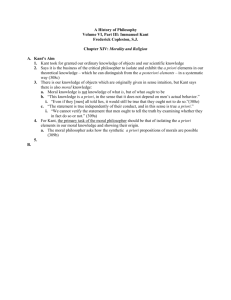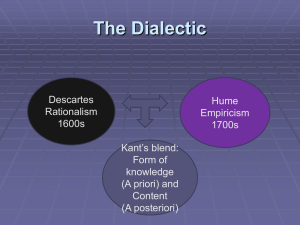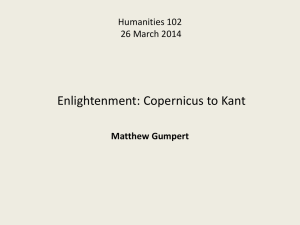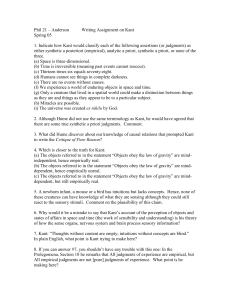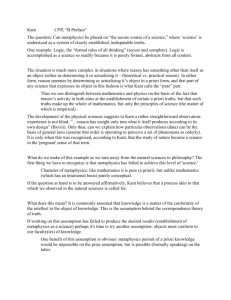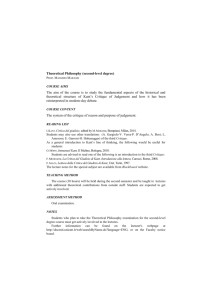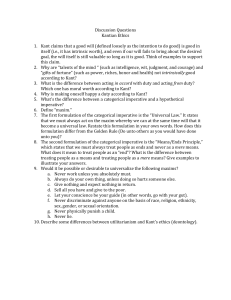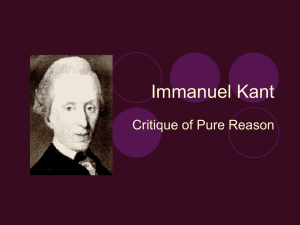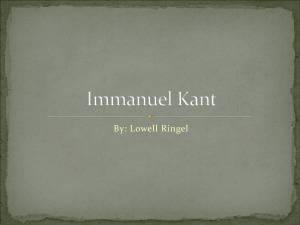Naturalism and the A Priori, by P. Maddy
advertisement
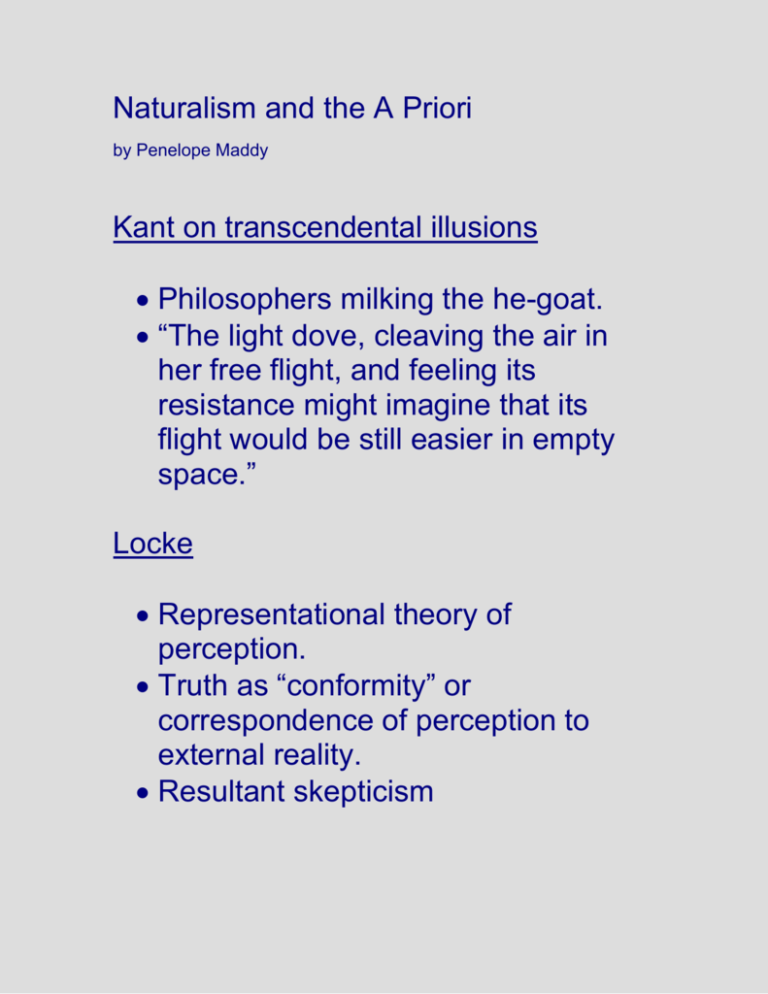
Naturalism and the A Priori by Penelope Maddy Kant on transcendental illusions Philosophers milking the he-goat. “The light dove, cleaving the air in her free flight, and feeling its resistance might imagine that its flight would be still easier in empty space.” Locke Representational theory of perception. Truth as “conformity” or correspondence of perception to external reality. Resultant skepticism Mind Matte r (The picture above actually does not capture Locke’s theory correctly, because on Locke’s view the greenness of the tree is a secondary quality, which is not a quality of the tree itself, but present in the mind only. On the other hand, the shape and size of the tree are primary qualities that exist in the world itself.) Berkeley’s Idealism Solves skepticism by elimination of extra-mental world. Objects become collections of sensations. God is the source of stability, objectivity. Kant’s Transcendental Idealism Basic Picture Private Experience Public Phenomena Noumena C a t e g o r i e s Space, Time, Causation, etc. ? Kant resolved the problem of Skepticism by allowing that there is no correspondence to the reality beyond experience, what Kant referred to as the noumenon. Space and time, however, are not properly conceived as aspects of the noumenon. Rather, they are what Kant calls a priori forms of intuition. Maddy gives two different readings of the Kantian scheme: Harsh Reading Heat, color, taste, space, time, and causation are all appearance, and no part of external reality. External reality is completely unknowable, however it affects our senses to cause the appearances. We call this the harsh reading because it is incoherent. External reality is at the same time represented as unknowable, and known to produce our experiences. The relation between the noumenon and our experiences would appear to be causal, even though causation is not a relation that it makes sense to apply to the noumenon. Benign Reading Although space and time are not aspects of the noumenon, they are distinct from sensations of color, taste, heat, etc. in that they provide the form of our experience and understanding, not the content. The content of our experiences changes, but the form does not, and this is why space and time are properly regarded as real and external to us, despite the fact that they are not aspects of the noumenon. Maddy makes this point very well: it is a misreading of Kant to think that on his view there are empirical objects and transcendental objects, where the latter gives rise to, or causes the former. Rather, there is an empirical and transcendental point of view. So, to take Maddy’s example: a rainbow may be described as a visual illusion, where the underlying reality is the interaction of electromagnetic radiation and water. But even EMR and H20 are perceptual objects when viewed from a transcendental point of view. Kant, then, is, like Locke, an empirical realist in the sense that science investigates an objective, external reality conditioned by space, time, and causation. This reality appears to everyone in the same way, and is not properly described as subjective However, he is a transcendental idealist in that he allows that even space and time are something that we impose, they do not correspond to an external reality. (Here he differs from Locke) Empirical Realist Kant (Phenomenal) Idealist Berkeley Locke (For Secondary Qualities) Transcendental Locke (For Kant (Noumenal) Primary Qualities) The main problem for the benign reading is to make sense of the relation between the noumena and phenomena. Kant explicitly repudiates the idea that transcendental objects cause empirical objects, since both the concept of “object” and the concept of “cause” do not have any application in the transcendental realm. This really seems to lead Kant directly to the kind of skepticism that plagued Locke. Kant is put in the position of saying that we humans have a hard time understanding how our perceptions could arise from nothing, but in the end there is nothing at all we can know about this noumenon. Kant’s reply to this objection is, essentially: don’t give me any shit. …For what is demanded is that we should be able to know things, and therefore intuit them, without sense, and therefore that we should have a faculty of knowledge altogether different than the human, and this not only in degree but as regards intuition likewise in kindin other words, that we should be not men, but beings of whom we are unable to say whether they are even possible, much less how they are constituted. One major problem for Kant scholarship, though, is that Kant does not really abide by this restriction on our knowledge of the noumenon. For example Kant’s notion of the self, what he calls the “transcendental unity of apperception” seems to be a noumenal object, or principle of precisely the sort that he regards above to be incoherent. The main problem for the benign reading Kant’s scheme allows for scientific inquiry within a certain a priori conception of space and time. It does not necessarily conflict with the idea that science discovers a reality permanently hidden from direct experience (i.e., the very small, the very far away, the very long ago). However, Kant’s philosophy expressly does not permit science somehow “discovering” that space and time are not absolute, or that the real world has more than 3 spatial dimensions, or that deterministic causation is not real. These are a priori truths, the very conditions of the possibility of scientific inquiry. Now, since these are precisely the sorts of things that what we understand scientists to have discovered the Kantian could respond in a few different ways. reject modern science (really bad idea) allow that a priori intuitions are not a priori, but revisable on empirical grounds (bummer for the whole Kantian system) allow that science actually can discover the nature of the noumenon (which is absurd given the way the noumenon is described) Before proceeding let’s be sure we are clear on some basic stuff that Maddy does not address in this article. Prior to Kant, David Hume had codified a very basic challenge to anyone who thought it was possible to have a priori knowledge of the world. Hume distinguished two ways in which a statement could be true. One way was for the statement to represent contingent matters of fact, the other was to express necessary relations of ideas. Kant distinguished these as synthetic and analytic truths respectively. Synthetic truths tell us the way the world is. Pluto orbits the sun. Rabbits have big ears. There are large pyramids in Egypt. Analytic truths tell us how idea or concepts are related. A planet is a celestial body that: (a) is in orbit around the Sun, (b) has sufficient mass for its self-gravity to overcome rigid body forces so that it assumes a hydrostatic equilibrium (nearly round) shape, and (c) has cleared the neighborhood around its orbit. The ear is a sense organ for hearing. A tetrahedron is a pyramid. Hume’s view gave us the following way of looking at the relation between epistemology and metaphysics. Known A Known A Priori Posteriori Analytic Truth Synthetic Truth X Ø K X Hume’s position serves a radical form of empiricism, but preserves the idea that at least some things are knowable a priori. For Hume, this would include all of logic and mathematics. But because logic and mathematics are not synthetic, it remains mysterious on Hume’s view why logic and mathematics actually seem to be useful in grasping the nature of the external world. Kant’s response was to claim that Hume overlooked another class of truths: the synthetic a priori. These are statements that are about the world, but knowable a priori. But Kant’s real contribution was to show how this could make sense to someone with strong empiricist sensibilities. If mathematical, geometrical, spatial and logical relationships are understood to be the forms of human experience understanding, then we can see statements representing these relationships as both knowable a priori and descriptive of the very structure of the empirical world. (Here is a good summary of the above.) The problem, however, is that these socalled necessary forms of intuition and understanding turn out not to be necessary at all. In modern science the concepts of time, geometry Carnap’s Linguistic Framework Carnap was one of the pioneers of the linguistic turn. For him, philosophy could only be done with a rigorous grasp of what a language is and how it works. One of the most important distinctions to grasp in this context is the difference between the “object” or what Carnap called the “thing” language, and the meta language. The object language is what we use to talk about the world. o Object language statement: There is a pig on the porch. The meta language is what we use to talk about language, specifically the object language. o Meta language statement: “There is a pig on the porch” is true. The meta language is what we use to specify the rules by which the object language works. It specifies: The symbols of the language. How the symbols are put together to form meaningful sentences. The basic axioms of the language. The rules of evidence for the language. So, for example, the meta language will specify what counts as evidence for the sentence “There is a pig on the porch” by specifying the experiences and relations that count as evidence for and against that statement. Carnap distinguished internal questions from external questions. Internal questions arise from within the thing language and are dealt with using the rules that it employs. An external question is a question about the language itself. Internal question: Is there a pig on the porch? This is a perfectly well formed question which can be answered using the specified rules of evidence. However, Is there an external physical reality? is what Carnap would call a pseudo question. It gets taken seriously because it has the grammatical form of an internal question. However, it is not an internal question that can be answered using the ordinary rules, but rather a confused question about the system itself. For Carnap, questions about reality arise only internal to the system. The rules of the language do not apply to questions about the system itself. We can ask meaningful questions about the system, but these are either going to be questions about how the system works; or whether we want to actually use the system. But this latter question can not be meaningfully answered by claiming that it represents reality better than other systems. Rather, one can only appeal to pragmatic criteria: effectiveness, simplicity, fruitfulness, etc.. Carnap’s a priori/ a posteriori distinction The concept of the a priori arises in Carnap’s system by reference to the linguistic rules. A statement will be a posteriori if the rules for confirming it specify that certain experiential states must be instantiated. A statement will be a priori if it can be confirmed simply by applying rules. To determine whether there are five pigs on the porch you will need to have 5 piggy porch experiences. However, to determine whether 5 is greater than 4, you need only apply the linguistic rules governing basic arithmetic. Comparison between Kant and Carnap (p. 104-105 Maddy) Kant distinguished between the empirical and the transcendental perspective. Carnap distinguished between the internal and the external perspective. For both Kant and Carnap, in order to understand how to answer a question we must be clear about the perspective from which it is asked. If we do not do this, then we end up posing pseudo questions and talking philosophical nonsense. For Kant (from the empirical perspective), and Carnap (from the internal perspective) the existence of space, time, physical objects, etc. is a priori. To question the reality of such things from within these perspectives is to pose a pseudo question. For Kant, these questions are always implicitly about the a priori forms of intuition. For Carnap these questions are always implicitly about the rules for the linguistic framework being used. The important dissimilarity is that Carnap does not think that we are necessarily constrained to the use of one language in the way that Kant thinks we are necessarily constrained to certain a priori forms of intuition. Furthermore, Kant and Carnap had the same problem with the transcendental perspective. Kant claimed that transcendental questions were ultimately unanswerable, because we could know nothing at all about the noumenon. But Kant in fact did try to say things about the noumenon. Carnap claimed that external questions were ultimately pragmatic questions about the value of a particular linguistic framework. But it isn’t clear what sort of linguistic framework we would use to pose and answer such questions. Is it a non conventional meta linguistic framework? If so, we need an account of it. If not, how would we evaluate the different answers given by different alternative meta-languages. The point here is that in both Kant and Carnap the viability of the higher perspective is dubious. Quine’s critique of Carnap (p. 105-106) Quine asserted very simply that the criteria we use for evaluating scientific hypotheses from within a particular linguistic framework are not different in kind from the criteria we use to determine whether we should expand or modify a particular linguistic framework. In other words: if we are operating within a particular scientific framework, with a particular ontology and rules of evidence specified, the value of a new hypothesis is determined by considerations of “simplicity, familiarity of principle, scope, fecundity, and consistency with experiment.” If, on the other hand, we are adopting an external perspective, and trying to determine whether we should modify the existing linguistic framework in some way (e.g., the basic ontology, or the rules of evidence) we would make exactly the same sorts of considerations. In other words, Carnap’s distinction between the internal and external perspectives does not correspond to a type difference in respect to the relevant considerations, though there may be a different emphasis. (E.g., consistency with experiment may figure more prominently in internal questions whereas conceptual simplicity may figure more prominently in external questions.) Neurath’s Boat The naturalist, then, rejects Carnap’s distinction between internal and external questions for the same reason that she rejects Kant’s distinction between the empirical and the transcendental: There is no distinct transcendental/external perspective to occupy. Quine: “It is within science itself, and not some prior philosophy, that reality is to be identified and described.” “Naturalism does not repudiate epistemology, but assimilates it to empirical psychology. Science itself tells us that our information about the world is limited to irritations of our surfaces, and then the epistemological question is in turn a question within science: the question how we human animals can have managed to arrive at science from such limited information.” “Neurath has likened science to a boat which, if we are to rebuild it, we must rebuild plank by plank while staying afloat in it. “The naturalist philosopher begins his reasoning within the inherited world theory as a going concern. He tentatively believes all of it, but believes also that some unidentified portions are wrong. He tries to improve, clarify, and understand the system from within. He is the busy sailor adrift on Neurath’s boat.” Challenges to Quinean Naturalism Question: Even if Quine is correct that there is no vantage point outside of science upon which to base a split-level conception of inquiry, it does not follow that science itself does not employ such a distinction internally. Maddy thinks science does in fact employ an important distinction between theories that are accepted as describing reality and those that are accepted on a conventional or pragmatic basis. Recall that from the Kantian point of view it makes no sense to ask whether space time really is 3-dimensional. Posed from the empirical point of view this is a category mistake, since 3dimensional space just is the form in which the empirical point of view is given. We’ve seen that the Kantian point of view is mistaken in this regard, since a multi-dimensional space is not only perfectly coherent, but scientifically useful as well. So it does make sense to ask whether space, time, causation, etc. are empirical realities or just useful fictions after all. Moreover, Maddy points out that working scientists do distinguish between the pragmatic value of a theory and its empirical reality. Atomic theory is the most recent example of this. In the early 20th century the theory of the atom was accepted as highly predictive and useful, but scientists did not begin to accept that it was an accurate representation of reality until long after all pragmatic tests had been passed. Interestingly, some theories do not even seem to be candidates for realistic interpretation no matter how useful they are. One current example of the above is the mathematical assumption that space-time is continuous, and that it can be modeled on the real numbers using the differential equations of the calculus. This assumption has been hugely productive. Scientists, however, continue to regard it as both a sensible and a completely open question whether space-time is really continuous. (Kant, of course, would have regarded it as neither.) Despite the fact that the empirical/pragmatic distinction is useful within science itself, Maddy concludes that it does not offer us an alternative conception of a priori knowledge. There is, in other words, no internally recognizable a priori criterion that must be met in order for a theory to count as empirical knowledge rather than just instrumentally useful. Maddy concludes that questions like these are inherently questions about the actual practice of science and can only be answered by inquiring into the psychological and social conditions the incline scientists to interpret the epistemic/pragmatic value of a theory in one way or another.
